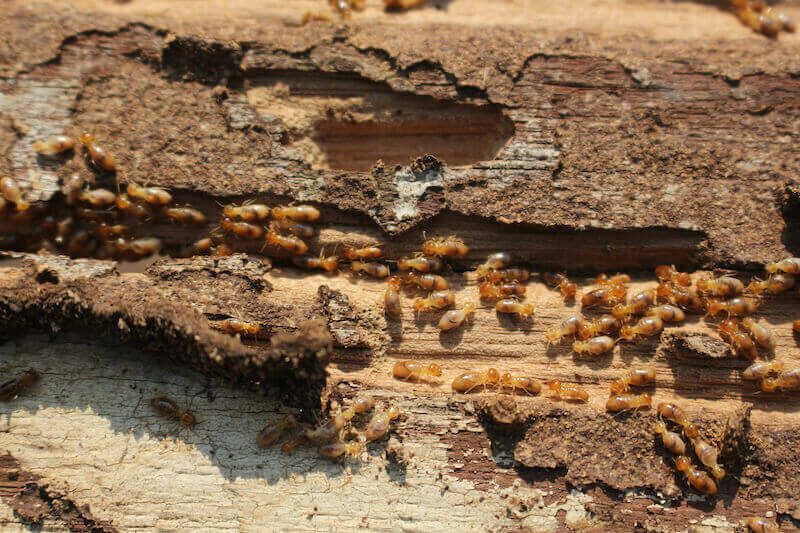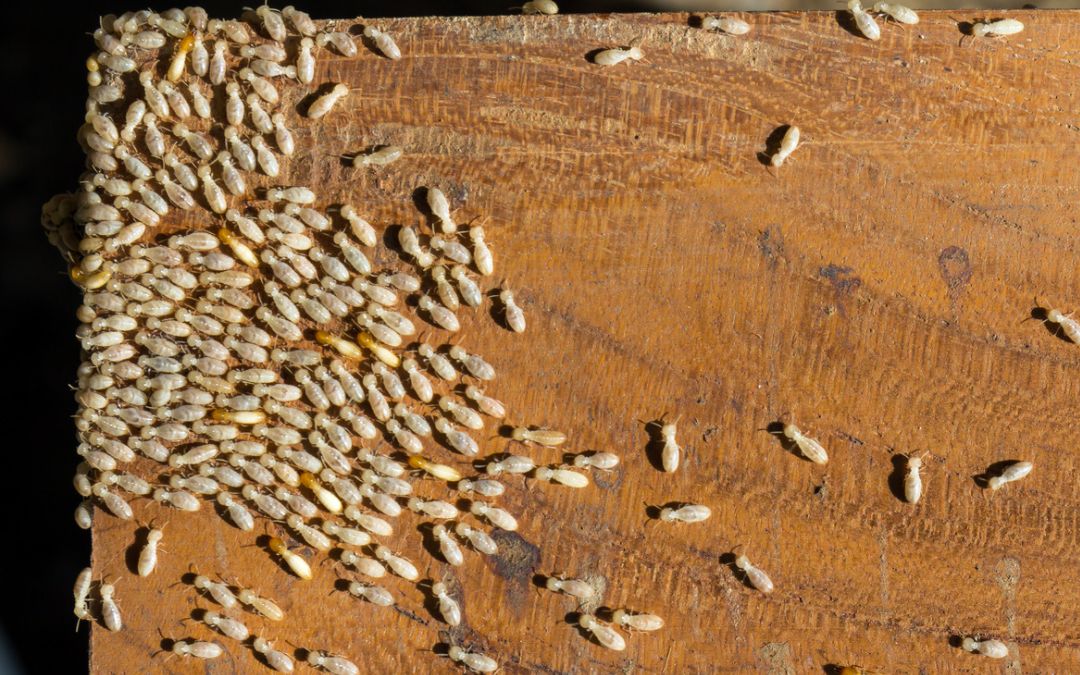Termite Treatments in Florida:
Exterminator Services for Bonita Springs, Naples, and Marco Island
Termites remain one of the most concerning pests in Florida’s subtropical climate, where warm temperatures and high humidity provide near-perfect conditions for these wood-eating insects year-round. Whether you own a waterside home in Bonita Springs, manage a commercial property in Naples, or operate a vacation rental on Marco Island, facing a termite infestation can raise major worries about structural damage and financial costs. This service page explores why termites thrive in Florida, how to spot early signs of infestation, and why consulting a professional termite exterminator is so critical to preserving your property’s integrity.
Why Termites Thrive in Florida

- Mild Winters
In colder states, prolonged freezing periods limit termite activity and slow breeding cycles. Southwest Florida rarely experiences these harsh lows, enabling termites to forage and reproduce with minimal interruption across all seasons. The mild winter months in Bonita Springs, Naples, and Marco Island therefore do little to curb termite populations. - High Humidity and Frequent Rainfall
Most termite species require consistent moisture, either from soil or decayed wood. Florida’s climate supplies plenty of humidity and showers, so damp soil and wooden structures remain accessible. Subterranean termites capitalize on wet ground to build mud tubes that protect them from open air. Drywood termites, meanwhile, prefer humid attics or roofing timbers that seldom dry completely. - Abundant Wooden Structures
From dockside developments to older beachfront homes, Florida’s architecture often incorporates wood framing, floors, or siding. Landscaping may include fences, decks, or decorative timbers near the soil. Without protective treatments and regular inspections, these wooden elements serve as a buffet for termites seeking cellulose. - Minimal Seasonal Dormancy
Many insects enter dormancy when temperatures plummet, reducing reproduction for months. In Florida, cooler stretches are brief, leaving only minimal natural breaks. This allows a small colony to quickly morph into a much larger infestation if undetected, presenting ongoing risks for structural supports and wooden fixtures. - Continual Construction and Renovations
Bonita Springs, Naples, and Marco Island see near-constant building and remodeling projects— sometimes disturbing the soil where subterranean termites nest or revealing new wood for drywood termites. Construction changes can inadvertently introduce fresh termite pathways or unprotected wood surfaces, intensifying potential invasion opportunities.
Common Termite Species in Florida
- Subterranean Termites (Reticulitermes spp.)
The most widespread, subterranean termites build extensive colonies underground, creating protective mud tubes that lead to wooden food sources. These termites can hollow out structural beams without obvious external signs of damage until serious weakening occurs. - Formosan Subterranean Termites (Coptotermes formosanus)
A more aggressive subterranean species, Formosan termites form huge colonies capable of consuming wood faster than typical termites. They often infiltrate walls or attics and can produce large carton nests that speed up colony growth. - Drywood Termites (Cryptotermes spp.)
Unlike subterranean types, drywood termites do not need soil contact. They inhabit relatively dry wooden structures—rafters, furniture, or hardwood floors—and expel small, pellet-like droppings known as frass. Although less numerous than their subterranean counterparts, drywood termites can still cause extensive damage if unnoticed in attics or behind walls. - Dampwood Termites
Preferring moist, decaying wood, dampwood termites occasionally appear in settings where water damage persists, such as rotted soffits or leaky decks. Although less common in well-maintained structures, they remain a concern near water-prone areas if neglected.
Warning Signs of a Termite Infestation
- Discarded Wings
Reproductive termites (swarmers) shed their wings after mating flights to begin new colonies. Spotting piles of transparent wings near window sills, door frames, or lighting indicates a nearby colony or the early formation of one. - Mud Tubes
Subterranean termites build thin, soil-and-saliva tubes along foundations or interior walls to maintain a humid tunnel. Discovering pencil-width mud lines climbing up concrete or wood strongly suggests active termite exploration. - Frass (Droppings)
Drywood termites leave behind small, hexagonal droppings that can accumulate near baseboards or window sills. If you spot grainy, sawdust-like piles in rarely disturbed corners, an infestation might be hidden just beyond sight. - Hollow or Damaged Wood
Because termites often consume wood from the inside out, tapping infested beams may produce a hollow sound. In advanced stages, surfaces may buckle or break under modest pressure. - Swarming Activity
Seeing winged termites flying around light fixtures or around property edges, especially after rainfall, can indicate a colony is close. Swarmers typically emerge to reproduce, so witnessing them indoors almost certainly means an existing nest is well-established.
The Necessity of Timely Termite Treatments
- Avoiding Structural Weakening
Left unchecked, termite feeding can undermine support beams, floor joists, and roofing timbers. Repairing such widespread damage often proves costly and time-consuming. Immediate action preserves the building’s integrity. - Preventing Financial Loss
Termite destruction impacts property values, complicates real estate transactions, and may spur substantial renovation expenses if an infestation is advanced. Inspections and proactive treatments protect long-term investments for homeowners and businesses. - Minimizing Health Concerns
Although termites do not typically transmit diseases, they can exacerbate allergies by introducing wood dust or mold in damp, gnawed-out cavities. Prompt resolution helps keep indoor air quality stable and surfaces intact. - Maintaining Peace of Mind
Living with the worry of unseen termite colonies chewing away behind walls fosters stress and uncertainty. A thorough exterminator service identifies nesting sites and eliminates pests, returning a sense of security to property owners.

Exterminator Solutions: Termite Control Strategies
- Inspection and Species Identification
A termite exterminator initiates control efforts by examining every accessible space—attics, crawl spaces, perimeter soil, wooden decks—to detect termite presence. Recognizing whether you face subterranean or drywood termites shapes the recommended methods. - Soil Treatments (Subterranean Termites)
For subterranean varieties, professionals often apply termiticides around foundations or in trenched perimeters. This creates a protective barrier that prevents worker termites from entering. Drilling or rodding methods may be used along exterior walls or floors where the colony is suspected. - Bait Systems
Bait stations containing slow-acting ingredients are placed around a property to lure foraging worker termites. The toxin-laced food returns to the nest, gradually killing the colony. Baits also help monitor continuing termite activity and allow for ongoing vigilance in Bonita Springs, Naples, or Marco Island properties. - Fumigation (Drywood Infestations)
Drywood termites that extensively infiltrate attics or multiple walls might require tent fumigation, saturating the entire structure with gas lethal to all life stages. After the airing-out process, homeowners can return to a pest-free space. Less severe or localized outbreaks may be resolved with spot treatments. - Moisture Control
Because termites thrive in damp wood, exterminators also encourage repairing leaks or improving drainage. Drying out musty attics, sealing cracks near roofing, and preventing standing water near foundations hamper termite breeding conditions.
Service Areas: Bonita Springs, Naples, and Marco Island
Bonita Springs: Merging residential growth with scenic waterways and golf courses, Bonita Springs often sees subterranean termites drawn to moisture-laden soils or yard mulch. New construction and older estates alike risk termite infiltration if structural wood remains unprotected.
Naples: Famed for luxury communities and a robust hospitality sector, Naples has a high volume of real estate transactions that often hinge on termite inspections. Swift, effective termite treatments preserve property values and reassure discerning homebuyers or renters.
Marco Island: A prime tourist destination replete with hotels, beachfront properties, and rental condos, Marco Island’s frequent occupant changes create multiple chances for unnoticed infestations. Subterranean termites can slip in from the soil, while drywood species can stow away in imported furniture or roof eaves.
Securing termite control in these communities ensures that residents and businesses alike avoid the structural pitfalls and financial burdens that accompany an unchecked colony.
Why Choose Our Termite Treatments
- Florida-Focused Insight
Handling termites in southwestern Florida requires specialized approaches, given the year-round mild climate and coastal humidity. Recognizing local termite species and their typical infiltration routes guides each step, from inspection to follow-up. - Versatile Techniques
Addressing subterranean and drywood termites demands distinct solutions—soil barriers, baits, fumigation, or spot treatments. Because every property differs in age, layout, and termite pressure, an adaptable game plan fosters comprehensive results. - Safe Application
Professionals use carefully selected termiticides and fumigants that, when properly applied, minimize exposure risks to residents, pets, and the local environment. Thoroughness and attention to detail keep the process safe, avoiding unnecessary chemical usage. - Preventive Guidance
Post-treatment recommendations—fixing leaky pipes, clearing wood piles away from exterior walls, or adjusting landscaping—help deter future termite infestations. With many termite species relying on consistent moisture or unprotected wood, these small changes can have a large impact. - Scheduled Monitoring
Subterranean termites sometimes reappear if new colonies form nearby or if the barrier around a structure degrades. Bait stations and periodic check-ups let technicians detect fresh activity, maintaining a protective shield around your property.
- Florida-Focused Insight

Next Steps
If you notice mud tubes near foundations, hear a hollow sound tapping on beams, or see discarded wings around windows, do not ignore these warning flags. Contact us to learn more or schedule your service. Our termite exterminator techniques tackle both drywood and subterranean termite challenges in Bonita Springs, Naples, and Marco Island, ensuring that each step addresses underlying issues and prevents resurgence.
Timely termite treatments protect your home or business from costly structural damage, maintain property values, and free you from daily anxieties about unseen colonies chewing away at supports. By intervening early, you control termite populations before they spread too extensively.
Sustaining a Termite-Free Lifestyle in Florida
Living in a subtropical region like Florida demands year-round attentiveness to wood-boring pests. Because these insects remain active nearly every month, an integrated strategy involving early detection, moisture control, and professional treatments stands as the best defense. For instance, sealing cracks in the foundation, storing firewood away from the exterior walls, and keeping gutters clear can reduce termite attractions.
Periodic inspections—particularly when buying or selling property—catch emerging colonies before they cause major destruction. A combination of soil treatments or bait stations for subterranean types, plus fumigation or localized application for drywood termites, ensures coverage for multiple scenarios. Working with an experienced extermination service grants deeper insight into southwestern Florida’s environment, giving you confidence that your investment remains free from termite-induced damage.
In a region as naturally beautiful as Bonita Springs, Naples, and Marco Island, you deserve the security that prompt, skillful termite management delivers. By partnering with specialized professionals, you ward off structural hazards and remain at ease, focusing on the benefits of coastal living—rather than constant apprehension about unseen feeders gnawing behind your walls.
